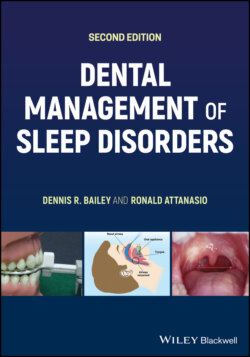Читать книгу Dental Management of Sleep Disorders - Ronald Attanasio - Страница 82
Sleep‐Related Movement Disorders
ОглавлениеIn this category, a number of these are commonly known but may not be fully understood. For sake of clarity, not all of them will be listed here, only the ones that the dentist may be more likely to encounter. The ones of greatest interest to the dentist are:
Restless legs syndrome (RLS or Willis–Ekbom disease)
This is a clinical diagnosis associated with the need to move the legs and associated with various sensations and is termed a sensorimotor disorder. Typically this may interfere with being comfortable and also being able to initiate sleep. There may be a familial pattern and is more common among women and during pregnancy.
Periodic limb movement disorder (PLMs or PLMD)
Periodic limb movements occur during sleep and involve mostly the legs. They are associated with arousals that can occur anytime during sleep. There may be a relationship with RLS. Low iron levels in the brain that are described as low serum ferritin levels are common. PLMs are most common during N2 sleep and are associated with dopamine deficiency. When present the need to evaluate for other sleep disorders like narcolepsy and the SRBD is recommended.
Sleep‐related bruxism
This is a condition that the dentist is very familiar with and is accustomed to managing. In the context of sleep disorders this is potentially related to other sleep disorders such as a SRBD or even RBD. This is related to rhythmic masticatory muscle activity (RMMA), to arousals, and occurs mainly during N2 sleep. The important consideration is that this may not be a single entity and other aspects of sleep and sleep disorders need to be considered.
Sleep‐related movement disorder due to a medical disorder
This refers to movements during sleep that are disruptive to sleep, may be neurologic in nature, and do not conform to other movement disorders.
Sleep‐related movement disorder due to a medication or substance
This is a movement disorder that is related to the use of a substance and cannot be classified as one of the other movement disorders.
Under the category of isolated symptoms and normal variants, the one of most interest is titled sleep starts, also termed hypnic jerks. There is no known cause or mechanism for these and are typically associated with sleep onset. This may be related to some disturbance in sensory processing during the wake–sleep transition.
